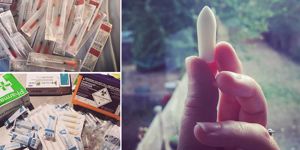A heads up: this will be a sensitive blog post for some. Even though we filmed each step on Facebook as it happened without knowing the outcome, with hindsight, our journey was very straightforward - both times. We were very lucky.
We understand IVF can be an incredibly tricky, emotional and devastating journey for so many, and this blog post is by no means a one-size-fits-all explanation of what happens. This is a blog post of what happened on our IVF journeys to give others a sense of what they might be able to expect.
Planning for an IVF cycle
The protocol
When you start an IVF cycle, one way or another, everything is about your ovaries. You’ll be given a protocol, a map of treatment to tell you which drugs you’ll need to take when, and the days you’ll be seen for scans and blood tests in preparation for egg collection.
Everything is subject to change, depending on how you and your ovaries react to the drugs. It’s a scary time, as you just don’t know what to expect – especially first time around.
IVF down-regging
Our IVF protocol started with downregulation drugs. These injections are used to quieten the womb. They reset your natural menstrual cycle to zero, causing an artificial menopause, and a clean slate from which to begin.
I started on a dose of 0.5ml of buserelin, via injection for 28 days, stopping only on the day of the trigger injection, and the day before egg collection.
16 day into my daily injections of buserelin, (around the time of my next expected period), they carried out a baseline transvaginal ultrasound scan to examine the ovaries. The purpose of this scan is to check the follicles, to make sure they’re not producing eggs and to measure the lining of the womb.
A blood test is also performed to measure the levels of serum estradiol – which is another indicator that the womb is ready for the next phase of the IVF process.
It was good news. My body was responding, and we were on track for the stimulation phase of treatment.
On day 17, I began a second injection of 300iu Menopur (which, by the way, I’ve heard is actually menopausal women’s urine. Bonkers.).
This dose was taken every day from day 17 to day 27. They monitor you closely during the stims phase to make sure everything is progressing as it should be, not too quickly, not too slowly.
Progress scans
I had three progress scans on day 23, 25, and 27 to measure the sizes and the number of the follicles. The data was plotted into the graph after each scan, so we could see the progress being made.
We found (as is to be expected), some variation in the sizes of follicles and their rates of growth. The aim is to end up with at least ten follicles that are deemed the right size and therefore ready for ovulation.
Doing a bit of research, it seems that the optimum size of follicles in the hope of harvesting a mature/viable egg is 16-20mm in average diameter on the day of your trigger injection. As you can see from my chart, on my last scan before trigger, I had around 13 follicles measuring 16 upwards.
It’s a real balancing act to get the sizes right. Once they measure past 24mm, they’re often too ripe and can’t be used.
Luckily, and according to plan, we had our third progress scan on day 27, which confirmed we were ready for egg collection.
The trigger injection
We stopped the daily menopur injection the same day, and the day after (day 28), we were advised to do the trigger injection, at 7.30 pm at night.
My trigger injection contained a drug called Gonasi, which acts to release the eggs from the walls of the follicles. It has to be done at a very specific time to correlate with the time of your operation the following day so that the eggs can be retrieved from the follicle fluid before they are released out of the ovaries.
The last dose of down reg/buserelin was also administered on the same day – two hours before the trigger injection.
I got pretty stressed about the trigger injection. It’s similar to the menopur in the respect that it’s a medication that has to be mixed, but unlike the menopur, which was really straight forward, the trigger seemed so much more complicated. The Gonasi drug came in the form of a large and more fancy looking syringe, with a big white plastic plunger, different vials and a whole new set of instructions that just seemed to be asking for something to go wrong. I guess that was simply down to the different pharmaceutical companies and their packaging.
I panicked that we’d administer it incorrectly, or do something to seriously jeopardise the entire cycle, after coming SO far. We struggled to get the air out of the mixture, and when we tried, we lost some of the dose out of the top of the syringe. In the end, I just jabbed in the air and the dose into my skin as it was, and hoped for the best.
What happens on egg collection day?
We left the house at 6.30 am on the morning following the trigger injection, to get to the clinic for our 7.30 am check-in. Full of excitement and nerves, it was game day. The day we both had to perform.
We settled into our room, and I changed into a hospital gown and some paper knickers. Admin and paperwork done, post-op lunch ordered and obs taken, it was time to wait to be called to surgery.
Walking down to theatre from my room on the ward for an egg collection operation was surreal. Lying down on the trolley feeling so excited and alert I wondered how on earth they’d be able to sedate me.
Meanwhile, Jamie had been ushered off to do his bit in “the” room. I had visions of him clearing out the barracks and missing the cup. Oh, the PRESSURE! But he got the job done, and I’m told it was without touching the door handles and most definitely NOT the box of magazines on the bedside table.
I felt like he had the worst part of the deal in a way, heading into the “wank room” of the hospital and being expected to whack off and make it a good one… After all, these were our children he was creating in that moment!
The next thing I knew, I was waking up spluttering and gasping for air in the recovery room wondering what had just happened, desperately wanting to ask the staff around me how it went.
We were lucky. For our first IVF cycle, 14 eggs were collected, with 11 being mature enough to fertilise, and our second, the same: 14 eggs were collected, but this time, all were mature enough to fertilise.
Unlike our first cycle, where half of the eggs were fertilised via IVF and half ICSI, our second cycle was 100% ICSI, after learning from our first cycle that our IVF did not work well for us.
Medication wise, the injections were over, but the cyclogest suppositories had only just begun. Affectionately known by many as ‘bum bullets’, these soft and slippery suppositories help maintain a uterus lining to support your embryo/pregnancy. They’re usually taken twice a day, am and pm starting the evening following your egg collection procedure, until a fair few weeks into your pregnancy.
The waiting game
The next few days were the most nerve-racking of all, as there was nothing else we could do but wait for the phone to ring. How many eggs have been fertilised? Were the cells dividing and doing so at the right speed?
The first call relayed brilliant news: 14 mature eggs were and injected, and out of those, 11 had fertilised. The next day, the update was that all 11 embryos were happily dividing, with 5 top quality embryos while the rest described as ‘average/poorer quality’.
It’s a massive, heart in your mouth race to embryo transfer day. That was the last update we received prior to turning up at the hospital just over two years ago. I remember being in the car on the way that morning in a complete panic, not even knowing what news would await us – whether or not there would be anything viable to transfer at all.
Embryo transfer day
We ended up having one embryo transferred, a day 5 4BB- but we were both shocked to hear that despite really positive progress with everything in play, there was nothing left to freeze. I found it incredibly disappointing that two days prior, all 11 embryos were happily diving with FIVE being described as top quality, to being left with only one viable embryo on transfer day. Them’s the breaks, I guess. I know we were lucky to have one to transfer, and as everybody in the IVF community will tell you – it only takes ONE.
An embryo transfer itself is pretty quick and straightforward. Our doctor led us into a small room containing a medic bed, a hatch in the wall and a screen, on which we saw our very best embryo in all his glory, now known as a ‘blastocyst’.
There I was, lying on my back on the hospital bed, staring up at the ceiling when the embryologist appeared in the hatch to confirm my name and date of birth.
“I hope they’ve got the right embryo” I thought silently, followed by “be careful with that thing!” as a giant embryo syringe was passed carefully through the hatch to the doctor.
And then it’s in. All of a sudden you have to get up, get your clothes on, and get on with your life while praying it doesn’t fall out, and that it sticks. Et voila! We had made it to the two-week wait.
The next day, we were called and told a day six blastocyst had made it to freezing, the same grade as the one we’d just transferred, just a day slower.
We have another embryo in the freezer from our first cycle of IVF, same day, same grade. Our kids are now 16 months and 3 years old, and so the question is – what do we do about our frosties?
If you’d like IVF/TTC support, join our Facebook group here: https://www.facebook.com/groups/ivfchat/








